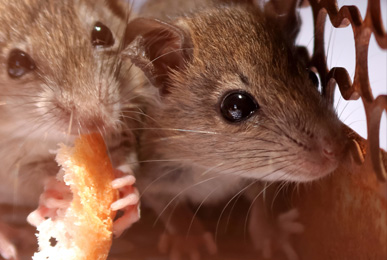


• Mus musculus
--- body length of 6~10cm, smallest in size among house mouse.
• Rattus rattus
--- body length of 16~21cm
• Rattus norvegicus
--- body length of 18~25cm, largest in size among house mouse.
1. Infectious diseases (mouse plagues, hantavirus and etc.)
2. Contaminates and destroys food
3. Stealing of food
4. Chewing through electrical wires, causing fires. Chewing through computer cords, causing computer errors.
5. Gnawing on boxes, cabinets, furniture, doors, windows, clothing and others.
6. Mouse biting.
7. Disturbing the peace.
1. Organize the environment:
Avoid sundries and indoor storage. Clean the kitchen waste regularly. Do not dispose food or leftovers by putting it down the drain. Disposal of rubbish should be handled properly, sealed and thrown as soon as possible.
Plug up the holes and cracks on the walls and fences. Gaps around the doors should not exceed 1cm. If there is a need, nailed a strip of wood or add a sheet metal to cover up.
2. Physical ways of preventing:
• To catch it using glue trap
• To kill it using snap trap
• To catch it using trap cage
• Ultrasound
• Ultraviolet
3. Chemical control methods:
• Fumigation
• Liquid bait
• Set up a bait station
• Poison powder
• Rats repellent
• Chemosterilants
There are 2 pairs of strong front teeth growing rapidly in the mouth of rats. They tend to grow around 13cm each year. Therefore, rats need to gnaw on hard objects constantly to wear their teeth down. Otherwise, teeth will grow long and begin to curl backwards. As a result, rats will be unable to eat and die because of hunger.
1. The spreading of Hantavirus is mainly due to the contacting of rodents’ droppings;
2. Or, inhaling of aerosolized virus that is shed in infected rodents’ faeces, droppings, urine, and etc., causing illness;
3. Or, effected through consuming of contaminated food.
Up to the present, virus being transmitted from person to person has not been proven yet, but it could be transmitted from mother to baby during pregnancy.
1. Hemorrhagic Fever with Renal Syndrome (HFRS):
Symptoms may develop within 5 days to 3 weeks after infection. These symptoms include fever, tiredness and muscles aches (normally on the back, shoulders and/or thighs). Other initial symptoms include headaches, dizzy, chills and abdominal pain (such as vomiting, nausea and/or diarrhoea).
2. Hantavirus Pulmonary Syndrome (HPS):
Early symptoms are fever, headaches, serious muscle aches such as aches on thighs, hips and back. Some will have abdominal problems, queasy, nausea, dizzy, chills and other symptoms. The late symptoms appear after 4 to 5 days, including severe hydropneumonia, coughing, shortness of breath, it can even be fatal when the condition got worse.
1. Store food and water in suitable containers, preventing infection of foraging rat.
2. If edible trash could not be thrown away immediately, it should be place in garbage cans with tightfitting lids.
3. Cutlery and kitchenware should be washed as soon as possible after using. Maintain the cleanliness of kitchen and your place.
4. Block all the rat holes and gaps around the house, preventing rats to enter.
5. While killing the rat, take precaution to kill the fleas and mites on it.
6. If clothes, utensils, and furniture are suspect to be infected by droppings of rat, you should wear masks and rubber gloves, clean them using detergents and dry them under the sun. Use floor cleaner or diluted household bleach to mop the floor and clean your house.
Supportive therapy is the mainstay of care for patients. It helps patients to pass through the critical stage by blood transfusion, cardiovascular medications and kidney dialysis. When respiratory failure happens, mechanical ventilator will be needed.
Plague, also known as Black Death. It earned its name for a symptom: victims had bleeding below the skin (subcutaneous haemorrhage) which blackened their bodies.
Plague is caused by Yersinia pestis which spread among humans and animals. Yersinia pestis can be carried by rats, cats, dogs and other animals, also some of the fleas. It is transmitted to humans by the bite of rodent fleas.
While pneumonic plague is transmitted by inhalation of aerosolized droplets.
Plague is divided into three types — bubonic, septicemic and pneumonic.
a. Bubonic plague:
Bubonic plague is transmitted to humans by the bite of infected rodent fleas. Incubation period are estimated from 2 to 7 days. After getting bite, the regional lymph nodes become swollen and extremely tender. These are called buboes. Swollen lymph nodes in the groin is most commonly seen, followed by swollen lymph nodes in the armpit. Lymph nodes swelling in the neck is least seen. Apart from that, having chills, fever, speeding up of heart rate, muscles aches, delirium, gastrointestinal symptoms are also the signs. If not promptly treated, it usually develop into pneumonia, or even cause septicaemia.
b. Septicemic plague:
Septicemic plague is the continuation of bubonic plague. Yersinia pestis infection spreads through the bloodstream of patient. This causes high fever, chills, speeding up of heart rate and breathing difficulties, profoundly low blood pressure and multi-organ failure. If not treated, death may follow in one to four days.
c. Pneumonic plague:
Pneumonic plague is mostly the continuation of Bubonic plague and Septicemic plague, caused by direct inhaling infectious dust containing yersinia pestis, or by close contact with patient suffering from plague. After the incubation period of 1 to 6 days, there will be symptoms of having chills, fever, coughing, severe chest pain, and blood in sputum. If left untreated, patients mostly die within 2 to 5 days.
Humans and animals can both get plague, the ways to prevent is:
1. First, kill the rat fleas, then only kill the rat. This is to prevent host-switching of parasite. Without rodent, rat fleas might attack and endanger human.
2. Avoid letting pets leaving the house often. This is to prevent pets bringing back the infected fleas, which will cause pets getting plague, and then transmit to human.
3. If discovered any case of plague, the patient should be quarantined and treated. While those whom contacted the patient should take medication to prevent getting infected.
As of now, plague could be treated by few kinds of antibiotics (Tetracycline, Streptomycin). As long as having early diagnosis and treatment, human can no longer be threaten by plague case fatality rate anymore.
Yersinia pestis vaccine must consists vaccination of 2 to 3 doses continuously. The efficacy would not last long. Therefore, other than the workers of epidemic area and laboratory, others are not encourage to have vaccination. The side effects of live attenuated vaccines are more serious and its’ protective effects are weak.
There have been three great world pandemics of plague recorded. The first time was between 520 to 565 CE. The epidemic was at Mediterranean littoral of Middle East. The death toll was around a hundred million people. It caused a downfall of the Eastern Roman Empire. The second pandemic was at 14th century (1346 to 1665), and it reached Europe, Asia, North Africa. The major epidemics was at Europe. It is conjectured that Europe has a population of one hundred million, a quarter died because of plague. It has seriously affected European religious and economic activities. The third pandemic was at late-19th-century (1894), until mid-20th-century. Experts believed that it was brought from Guangdong and Hong Kong, spread along sea trade routes to past 60 countries of Asia, Europe, America and Africa. Nearly all the coastal regions and near-coastal-inlands of the whole world became epidemic area. Nations were tensed because it had been a while since the last plague attack. Additionally, plague was also known as the Black Death, a pandemic with high mortality rate. These factors caused public to be fear and panic.